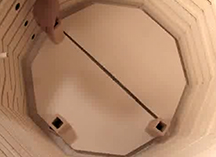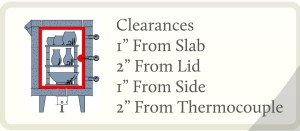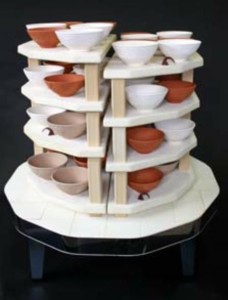Loading your kiln properly is one of the keys to successful firings. A little planning ahead of time cane save you a world of headaches. Here are some of the things you want to consider before you load the kiln.
 Keep It Separated
Keep It Separated
Does everything in your kiln fire to the same temperature with the same program? Loading items in your kiln that fire to different temperatures can be disastrous. For example, an Earthenware clay will completely melt if fired to Stoneware temperatures. When firing ceramics you want to keep bisque firings and glaze firings separate and make sure that the glazes and clay bodies in each load are designed to fire to the same temperature using the same program.
This is also true with glass. Manufacturers recommend different firing programs for different COE glass. If you choose to work with a variety of glass, clay and glaze we recommend you store them on different shelves to keep from mixing them up.
 Watch Your Clearances
Watch Your Clearances
Clearances between pieces and from the kiln itself are important when loading your kiln. When loading pieces on a kiln shelf you want to be sure nothing is touching. When fusing multiple layers of glass you need to remember that when the glass melts it can extend beyond its original footprint. Just because a project isn’t touching when you load it doesn’t mean it wont touch when it is fired.
Items located too close to the elements can receive more heat then the rest of the load and items loaded too close to lids and slabs that do not have elements may be underfired. Also it is important to keep pieces and shelves at least 2” from the thermocouple to avoid biasing the reading.
 Load Evenly
Load Evenly
The key to a nice even temperature from top to bottom is loading the mass in the kiln evenly. If you have a large kiln this can take some planning. The tendency is to load it really heavy on the bottom anticipating you wont have enough room or real heavy on top after you realize you are not going to have enough room. Both of these are bad.
One trick is to cut out pieces of cardboard the size of your shelves and place your ware on those as they are drying or are assembled. When you have filled the cardboard you know you have a full shelf of ware. It also helps to place pieces of equal height on the same piece of cardboard. This way you ensure the kiln will be loaded with a minimum amount of wasted space between shelves.



